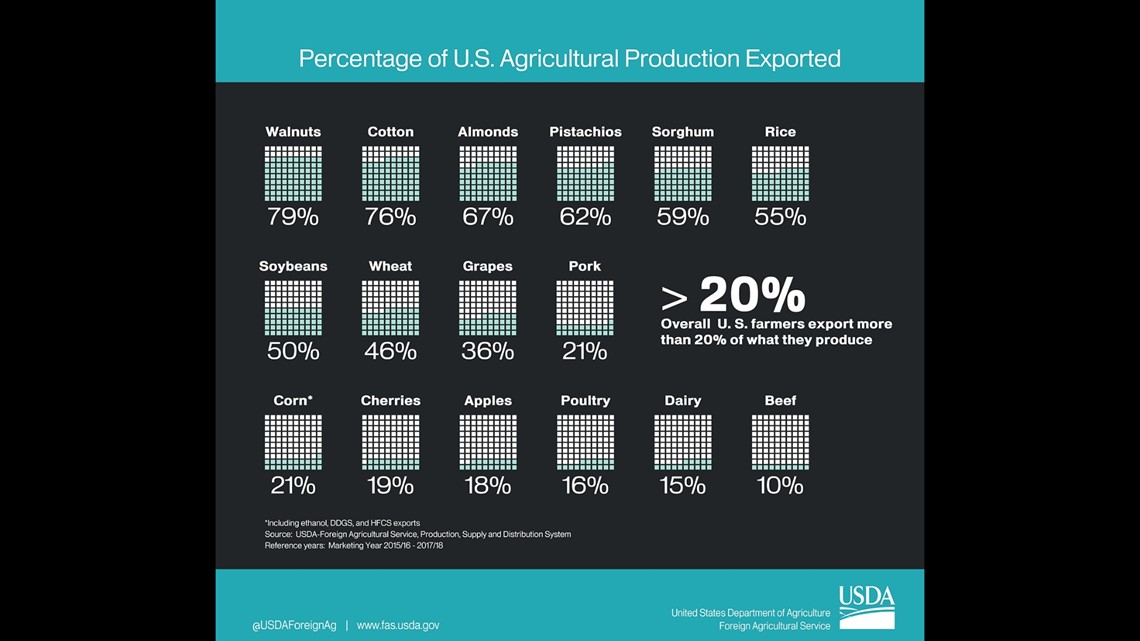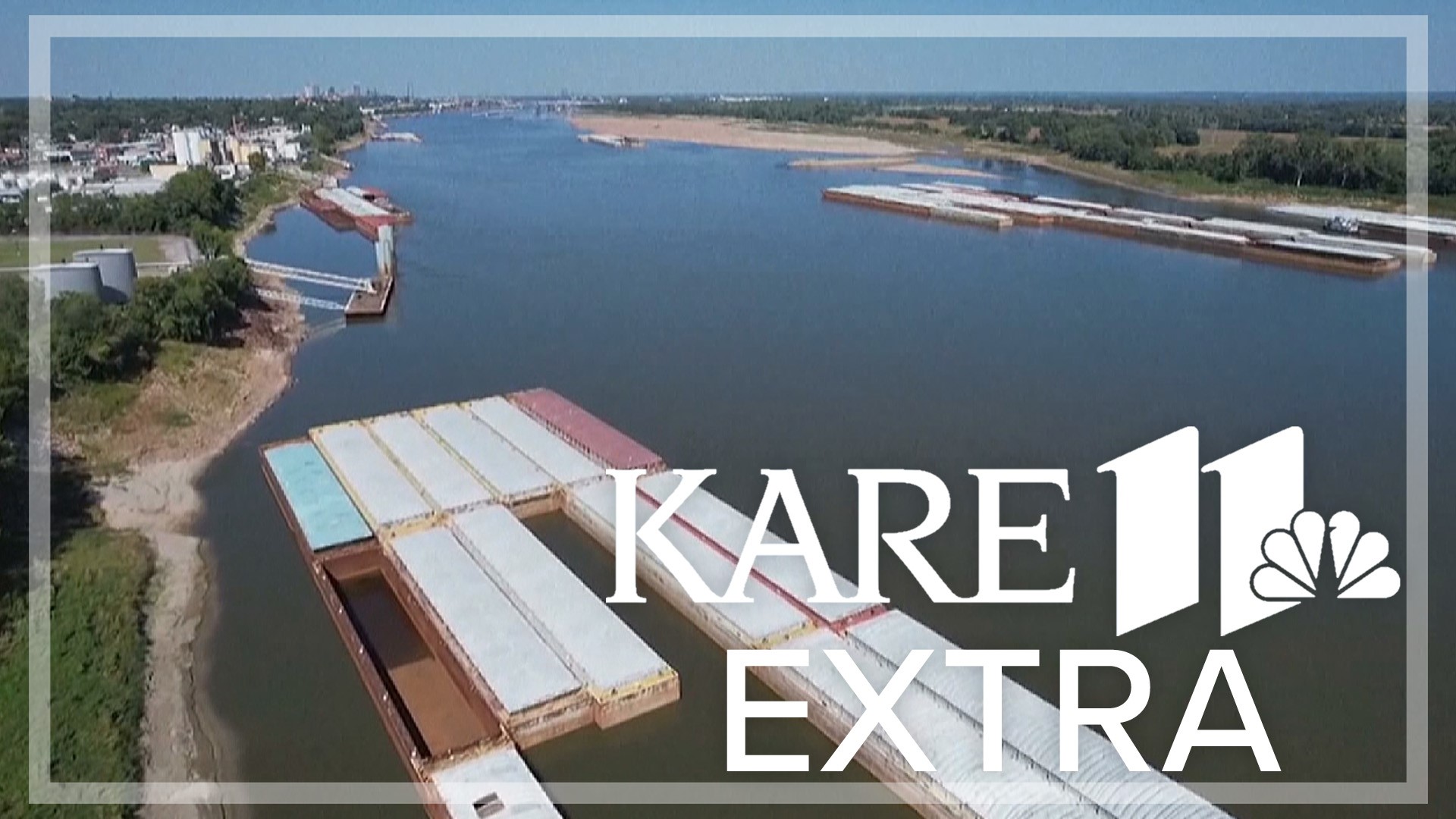ST PAUL, Minn. — For the second year in a row, drought conditions are thinning out the depth and width of the Mighty Mississippi River, America's commodity-carrying superhighway.
Nearly half of all the rice, soybeans and wheat produced in the U.S. is exported, according to the USDA, and the Mississippi River carries roughly 60% of all grain that leaves the country.
“The Mississippi River is an important part to the profitability of Minnesota agriculture,” said Mike Steenhoek, executive director of the Soy Transportation Coalition. “Now we are experiencing a movie sequel that none of us want to watch.”
Call it environmental irony. Rain puts harvesting farmers behind, but a severe lack of rain has crippled the ability to ship those farmed goods.


“The drought years have impacted us in ways we'd never imagine they would impact us,” said Lee Nelson, co-owner of Upper River Services in St. Paul.
His company tows, cleans and valet parks barges that come up from the south, getting them ready to load up commodities to be sent back down river to New Orleans, and out to the world.
“The entire system is less efficient because of the drought. We are moving slower. We aren't moving as much as quickly, and we can't move as much in one trip, but we are still moving. We haven't stopped,” said Nelson.
You may look at the Mississippi River in St Paul or Hastings and think, "It doesn't seem all that low?" That’s because it’s not. The upper part of the river is what's called a pooled system—a series of locks and dams that allow us to hold water back to maintain certain river depths. It's especially important during a drought.
At Lock and Dam No. 2 in Hastings, the water is 12 feet lower on one side of the structure than the other, and those water depths go all the way until the next lock and dam.
But south of St. Louis, there are no locks or dams. Three giant rivers converge making the Mississippi too big and the building cost of such dams too expensive.
The problem is drought. The entire path along the Mississippi River in early November was in what the U.S. Drought Monitor dubs "moderate drought" to "exceptional drought."
The lack of rain feeding the river, over time, has created unprecedented low water depths in some parts of the river.
Since 2018, the river depth in St. Paul dropped 9 feet. In Guttenburg, Iowa, it's down 6 feet. Thanks to the dams, experts say that's no problem. But keep going south. In the same five years, the river depth sank 30 feet in St Louis, 31 feet in Memphis and 32 feet in Vicksburg, Mississippi.
“In 30 years, this has been the most stressful harvest I've endured,” said George Leavell, president of Wepfer Marine. The company tows and services barges at seven ports on the Mississippi River in Memphis.
He says a narrower river means fewer barges in a tow. A shallower river means loading each barge with less weight. This slows down shipping, increases demand, and has doubled the price to ship goods on the river compared to the previous three-year average.
In 2022, stuck barges near St. Louis shut the river down for days, creating a 2000 barge backup.
It’s a challenge, no one has faced quite like this before.
“It is personal to me. Spent 30 years here. This is where I have my money invested. I have friends that are farmers and friends in other industries that are dependent on this river. To keep their businesses open and their farms alive and well. It is personal,” said Leavell.
Jeff Webb is general manager of Marine and Terminal for Cargill, one of the largest grain exporters in the world. The Mississippi River is critical to their business.
“That used to be a highway—an interstate, and what we've done is we've made it into—in some cases—a one lane road,” said Webb.
A single barge can carry the equivalent of 16 rail cars or 70 semi-trucks.
One single tow of barges tied together can equal 1,000 semi-trucks, and the river can do it with roughly 4-and-a-half times the fuel efficiency of a truck.
“We couldn't find enough trucks or enough rail cars to move all the commodities out of here down to New Orleans. It just wouldn't be feasible,” said Webb.
Without significant and more consistent rain – the only weapon the river industry has against drought is dredging.
The U.S. Army Corps of Engineers operates boats with giant excavators or vacuums on board, scooping and slurping up the river bottom in crucial low spots.
They must maintain a 9-foot clearance for barges to make it through.
After the crisis last year, the Corps got out earlier this year with more dredges in the Lower river, some operating 24-7 to clear the path for harvest traffic.
“If we aren't out here servicing the locks and dams, doing the necessary dredging, ultimately what could happen is the river could shut down, and that impacts everyone,” said Patrick Moes, a spokesperson for the U.S. Army Corps of Engineers.
The world economy relies on this river. Delays ripple like an economic earthquake: the transporters, the farmers, the wholesalers, and eventually the bill at your grocery store, all take a hit when the sailing isn't smooth. The last two years have been a warning for what lies downstream.
“We have one river and a vast number of legitimate beneficiaries of that river. The charge for all of us no matter what generation you are a part of is to figure out how we best coexist, and how do we maintain this fantastic piece of nature that's provided so much for us,” said Nelson.
Watch more local news:
Watch the latest local news from the Twin Cities and across Minnesota in our YouTube playlist:
WATCH MORE ON KARE 11+
Download the free KARE 11+ app for Roku, Fire TV, Apple TV and other smart TV platforms to watch more from KARE 11 anytime! The KARE 11+ app includes live streams of all of KARE 11's newscasts. You'll also find on-demand replays of newscasts; the latest from KARE 11 Investigates, Breaking the News and the Land of 10,000 Stories; exclusive programs like Verify and HeartThreads; and Minnesota sports talk from our partners at Locked On Minnesota.
- Add KARE 11+ on Roku here or by searching for KARE 11 in the Roku Channel Store.
- Add KARE 11+ on Fire TV here or by searching for KARE 11 in the Amazon App Store.
- Learn more about the KARE 11+ app for Apple TV in the Apple App Store.
- Learn more about KARE 11+ here.

